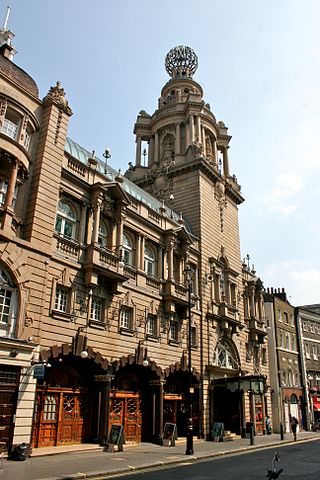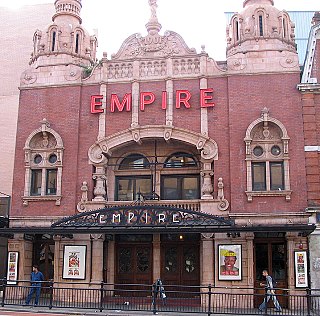
The London Coliseum is a theatre in St Martin's Lane, Westminster, built as one of London's largest and most luxurious "family" variety theatres. Opened on 24 December 1904 as the London Coliseum Theatre of Varieties, it was designed by the architect Frank Matcham for the impresario Oswald Stoll. Their ambition was to build the largest and finest music hall, described as the "people's palace of entertainment" of its age.

The Edinburgh International Festival is an annual arts festival in Edinburgh, Scotland, spread over the final three weeks in August. Notable figures from the international world of music and the performing arts are invited to join the festival. Visual art exhibitions, talks and workshops are also hosted.

The Theatre Royal is a historic theatre, a Grade I listed building situated on Grey Street in Newcastle upon Tyne.

The Hippodrome is a building on the corner of Cranbourn Street and Charing Cross Road in the City of Westminster, London. The name was used for many different theatres and music halls, of which the London Hippodrome is one of only a few survivors. Hippodrome is an archaic word referring to places that host horse races and other forms of equestrian entertainment.

The Palace Theatre is one of the main theatres in Manchester, England. It is situated on Oxford Street, on the north-east corner of the intersection with Whitworth Street. The Palace and its sister theatre the Opera House on Quay Street are operated by the same parent company, Ambassador Theatre Group. The original capacity of 3,675 has been reduced to its current 1,955.

Buxton Opera House is in The Square, Buxton, Derbyshire, England. It is a 902-seat opera house that hosts the annual Buxton Festival and the International Gilbert and Sullivan Festival, among others, as well as pantomime at Christmas, musicals and other entertainments year-round. Hosting live performances until 1927, the theatre then was used mostly as a cinema until 1976. In 1979, it was refurbished and reopened as a venue for live performance.

Francis Matcham was an English architect who specialised in the design of theatres and music halls. He worked extensively in London, predominantly under Moss Empires for whom he designed the Hippodrome in 1900, Hackney Empire (1901), Coliseum (1903) and Palladium (1910). His last major commission before retirement was the Victoria Palace Theatre (1911) for the variety magnate Alfred Butt. During his 40-year career, Matcham was responsible for the design and construction of over 90 theatres and the redesign and refurbishment of a further 80 throughout the United Kingdom.

The Theatre Royal is the oldest theatre in Glasgow and the longest running in Scotland. Located at 282 Hope Street, its front door was originally round the corner in Cowcaddens Street. It currently accommodates 1,541 people and is owned by Scottish Opera. The theatre opened in 1867, adopting the name Theatre Royal two years later. It is also the birthplace of Howard & Wyndham Ltd, owners and managers of theatres in Scotland and England until the 1970s, created by its chairman Baillie Michael Simons in 1895. It was Simons who as a cultural entrepreneur of his day also promoted the building of Kelvingrove Art Gallery and Museum and Glasgow's International Exhibitions of 1888 and 1901.

The Tivoli Theatre is a theatre in Aberdeen, Scotland, opened in 1872 as Her Majesty's Theatre and was built by the Aberdeen Theatre and Opera House Company Ltd, under architects James Matthews of Aberdeen and Charles J. Phipps, a London-based architect brought in to consult. The auditorium was rebuilt in 1897 by theatre architect Frank Matcham, but then closed temporarily in 1906, following the opening of the larger His Majesty's Theatre. The smaller theatre was extensively reconstructed in 1909, again by Frank Matcham, and re-opened in July 1910 as the Tivoli. The Tivoli was refurbished again in 1938.

The Cameo is a cinema in Tollcross, Edinburgh, Scotland, originally named the King's Cinema. It opened on 8 January 1914, making it one of the oldest cinemas in Scotland still in use. Since becoming the Cameo in 1949 it has had a tradition of showing art house films, becoming an important venue for the Edinburgh International Film Festival. Since 1992 it has had three screens. The Cameo was independent until 2003, when it was bought by Cineworld's Picturehouse chain.

Hackney Empire is a theatre on Mare Street, in Hackney in the London Borough of Hackney. Originally designed by Frank Matcham it was built in 1901 as a music hall, and expanded in 2001. Described by The Guardian as "the most beautiful theatre in London" it is an Arts Council England National Portfolio Organisation.
Sigmund Neuberger, who performed as an illusionist under the stage name The Great Lafayette, was the highest-paid magician of his time.

Eden Court Theatre is a large theatre, cinema and arts venue situated in Inverness, Scotland close to the banks of the River Ness. The theatre has recently undergone a complete refurbishment and major extension, adding a second theatre, two dedicated cinema screens, two performance/dance studios, improved dressing room and green room facilities and additional office space. The theatre's restaurant and bar facilities have also been totally overhauled and improved.

There are a number of reportedly haunted locations in Scotland.

The New Theatre Royal is a Victorian Grade II* listed theatre in the heart of Portsmouth, England, with a capacity of 648. The theatre building was constructed in 1854 as Landport Hall. It was converted to a theatre two years later. It was rebuilt in 1884 by Charles J. Phipps and again in 1900 by Frank Matcham.
Edinburgh International Magic Festival, also known as MagicFest, is an annual arts festival which takes place in Edinburgh, Scotland in the first week of July each year.
Events from the year 1911 in Scotland.
The Theatre Royal, Hanley was a theatre in Stoke-on-Trent, England with a long history.

The English architect Frank Matcham was responsible for the design and refurbishment of around 164 buildings, mostly theatres, throughout the United Kingdom. He entered the architectural profession when he was 21, in 1874, and joined the practice of J. T. Robinson, his future father-in-law, a few years later. Matcham completed his first solo design, the Elephant and Castle theatre, in June 1879, having taken over Robinson's practice upon his death. He founded his own practice, Matcham & Co., in 1883 which experienced much prosperity. His most successful period was between 1892 and 1912, during which there was an increased demand for variety theatres which resulted in the closure and dismantlement of many music halls, which had become outdated.

Duncan Frazer Hendry was the former Chief Executive of Aberdeen Performing Arts and of Edinburgh's Capital Theatres.




















